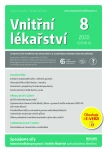Dissection of ascending aorta, a diagnosis needs to remember about it
Authors:
Veronika Jankovičová; Margita Belicová; Milan Ochodnický; Marián Mokáň
Authors‘ workplace:
I. interná klinika, Univerzitná nemocnica a JLF UK v Martine
Published in:
Vnitř Lék 2020; 66(8): 55-60
Category:
Case Report
Overview
Acute type A aortic dissection is a life-threating condition, and is associated with significant morbidity and mortality. Patients typically present with the acute onset of chest pain, which occurs in up to 85% of cases. Acute chest pain may lead to the suspicion of acute coronary syndrome, and as the electrocardiogram may indicate ischaemia, patients are given anti-throm‑ botic treatment. Some patients can present without chest pain, but with focal neurological deficits, which can occur with involvement of the great vessel. The authors described three patients with acute type A aortic dissection. Two of them did not present with the acute onset of chest pain, but with focal neurological deficits. Third patient presented with the acute onset of chest pain and the electrocardiogram indicated suspected ischaemia, which led to the suspicion of acute coronary syndrome. The authors presented, that diagnosis of acute type A aortic dissection can be easily overlooked and a high index of suspicion is needed to obtain a timely diagnosis such that appropriate initial therapy can be instituted promptly.
Keywords:
Aorta – acute type A aortic dissection – acute coronary syndrome – stroke.
Sources
1. Erbel R, Aboyans V, Boileau C, et al. The Task Force for the Diagnosis and Treatment of Aortic Diseases of the European Society of Cardiology (ESC). Eur Heart J 2014; 35: 2873–2926.
2. Gawinecka J, Schonrath F, von Eckardstein A. Acute aortic dissection: pathogenesis, risk factors and diagnosis. Swiss Med Wkly. 2017; (25); 147: w14489. doi: 10.4414/smw.2017.14489. e Collection 2017.
3. Lau C, Leonard JR, Iannacone E, Gaudino M, Girardi LN. Surgery for Acute Presentation of Thoracoabdominal Aortic Disease. Semin. Thorac. Cardiovasc. Surg. 2019; 31(1): 11-16.
4. Baliyan V, Parakh A, Prabhakar AM, Hedgire S. Acute aortic syndromes and aortic emergencies. Cardiovasc Diagn Ther. 2018; 8(1): S82–S96.
5. Berretta P, Cefarelli M, Montalto A, et al. Surgical indications for thoracic aortic disease: beyond the „magicnumbers“ of aortic diameter. Ital Cardiol. 2018; 19(7): 429–436.
6. Nienaber CA, Powell JT. Management of acute aortic syndromes. Eur Heart J. 2012; 33: 26–35 b.
7. Isselbacher EM, Lino Cardenas CL, Lindsay ME. Hereditary influence in thoracic aortic aneurysm and dissection. Circulation. 2016; 133(24): 2516–2528.
8. Rozado J, Martin M, Pascual I, et al. Comparing American, European and Asian practice guidelines for aortic diseases. J Thocac, DiS. 2017; 9(6): S551–S560.
9. Catherine M. Otto. Textbook of clinical echocardiography. 5th edition. Philadephia: El‑ sevier, 2013. ISBN 978-1-14557-287-2. Chapter 11, Valvular stenosis, p. 271–298.
10. Zeng T, Shi L, Ji Q, et al. Cytokines in aortic dissection. Clin. Chim. Acta. 2018; 486: 177–182.
11. Klompas M. Does this patient have an acute thoracic aortic dissection? JAMA 2002; 287: 2262–2272.
12. Kreibich M, Bavaria JE, Branchetti E, et al. Management of Patients With Coronary Artery Malperfusion Secondary to Type A Aortic Dissection. Ann Thorac Sur. 2019; 107(4): 1174–1180.
13. Di Eusanio M, Trimarchi S, Patel HJ et al. Clinical presentation, management, and short‑term out come of patients with type A acute dissection complicated by mesenteric malperfusion: observations from the International Registry of Acute Aortic Dissection. J Thorac Cardiovasc Surg. 2013; 145: 385–390.
14. Rogers AM, Hermann LK, Booher AM, et al. Sensitivity of the aortic dissection detection risk score, a novel guideline‑based tool for identification of acute aortic dissection at initial presentation: results from the international registry of acute aortic dissection. Circulation 2011; 123: 2213–2218.
15. Nienaber CA, Clough RE. Management of acute aortic dissection. Lancet 2015; 385: 800–811.
16. Hansen MS, Nogareda GJ, Hutchison SJ. Frequency of and inappropriate treatment of misdiagnosis of acute aortic dissection. Am J Cardiol 2007; 99: 852–856.
17. Bechtel JF, Erasmi AW, Misfeld M, Sievers HH. Reconstructive surgery of the aortic valve: the Ross, David and Yacoub procedures. Herz 2006; 31(5): 413–422.
18. Goldfinger JZ, Halperin JL, Marin ML, et al. Thoracic aortic aneurysm and dissection. J Am CollCardiol. 2014; 64: 1725–1739.
19. Nishida H, Tabata M, Fukui T, et al. A systemic approach to improve the outcomes of type A aortic dissection. J ThoracCardiovacsSurg. 2017; 154: 89–96.
20. Gomibuchi T, Seto T, Komatsu M, Tanaka H, Ichimura H, Yamamoto T, Ohashi N, Wada Y, Okada K. Impact of Frailty on Outcomes in Acute Type A Aortic Dissection. Ann. Thorac. Surg. 2018; 106(5): 1349–1355.
21. Kim JH, Choi JB, Kim TY, Kim KH, Kuh JH. Simplified surgical approach to improve surgical outcomes in the center with a small volume of acute type A aortic dissection surgery. Technol Health Care. 2018; 26(4): 675–685.
Labels
Diabetology Endocrinology Internal medicineArticle was published in
Internal Medicine

2020 Issue 8
Most read in this issue
- Dialysis patient in internal medicine inpatient ward
- Obesity-associated changes in drug pharmacokinetics
- Heparin induced thrombocytopenia and up to date options of treatment – review of literature
- Danger of the sea‑complications After Scorpion Fish Attack
